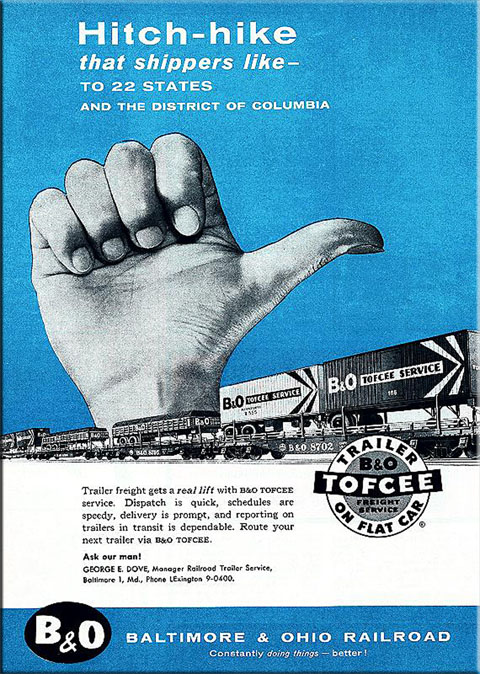Well Cars (Trains): Length, Overview, Specs
Last revised: February 25, 2025
By: Adam Burns
Today’s well cars go by many names (double-stack cars, for instance) but their primary purpose has not changed over the past twenty years or so; to haul international containers in loads of one or two from port to market and vice-versa.
While the car has been embraced by railroads for its efficiency it is actually little more than a glorified flat car.
The well car was also another step in the evolution of COFC service (said "Cof-cee"), or "Container On Flat Car."
You might be surprised to learn that while the movement of intermodal freight in such large quantities is a relatively recent phenomenon, its history and experimentation within the industry can be traced back decades to around the time of World War II!
During this time railroads like the Pennsylvania, Baltimore & Ohio, Erie, and New York Central all tested the concept although it remained relatively isolated to the testbed sector.
It slowly grew from the 1950s to become a major source of traffic for roads like Conrail and the Santa Fe during the 1980s. Today, most Class Is now derive a substantial source of annual revenue from the movement of intermodal.
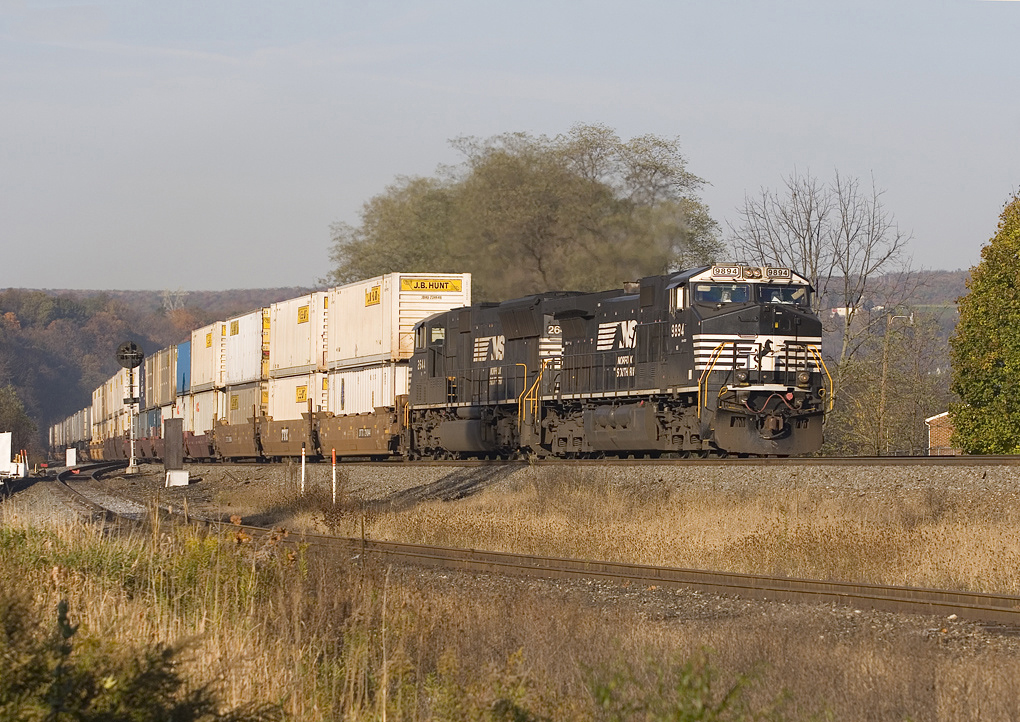 Norfolk Southern C40-9W #9894 and SD70M #2644 grind up grade with stack train 20W at Portage, Pennsylvania on October 20, 2009. Wade Massie photo.
Norfolk Southern C40-9W #9894 and SD70M #2644 grind up grade with stack train 20W at Portage, Pennsylvania on October 20, 2009. Wade Massie photo.The beginnings of COFC date back to the 1940s and 1950s when railroads began experimenting with TOFC service (said "Tof-cee").
The Baltimore & Ohio actually employed the saying when it marketed its TOFCEE service for many years through the 1960s and 1970s, or "Trailer On Flat Car."
One of the first lines to try out this new type of freight, moving either trailers or containers, was the Pennsylvania Railroad.
The service was pretty straightforward as it basically involved standard 40-foot flatcars to haul truck trailers in large numbers.
This setup benefited the trucking companies allowing for several of their trailers to be moved over long distances, which is often quicker and cheaper while also providing railroads with another means of traffic.
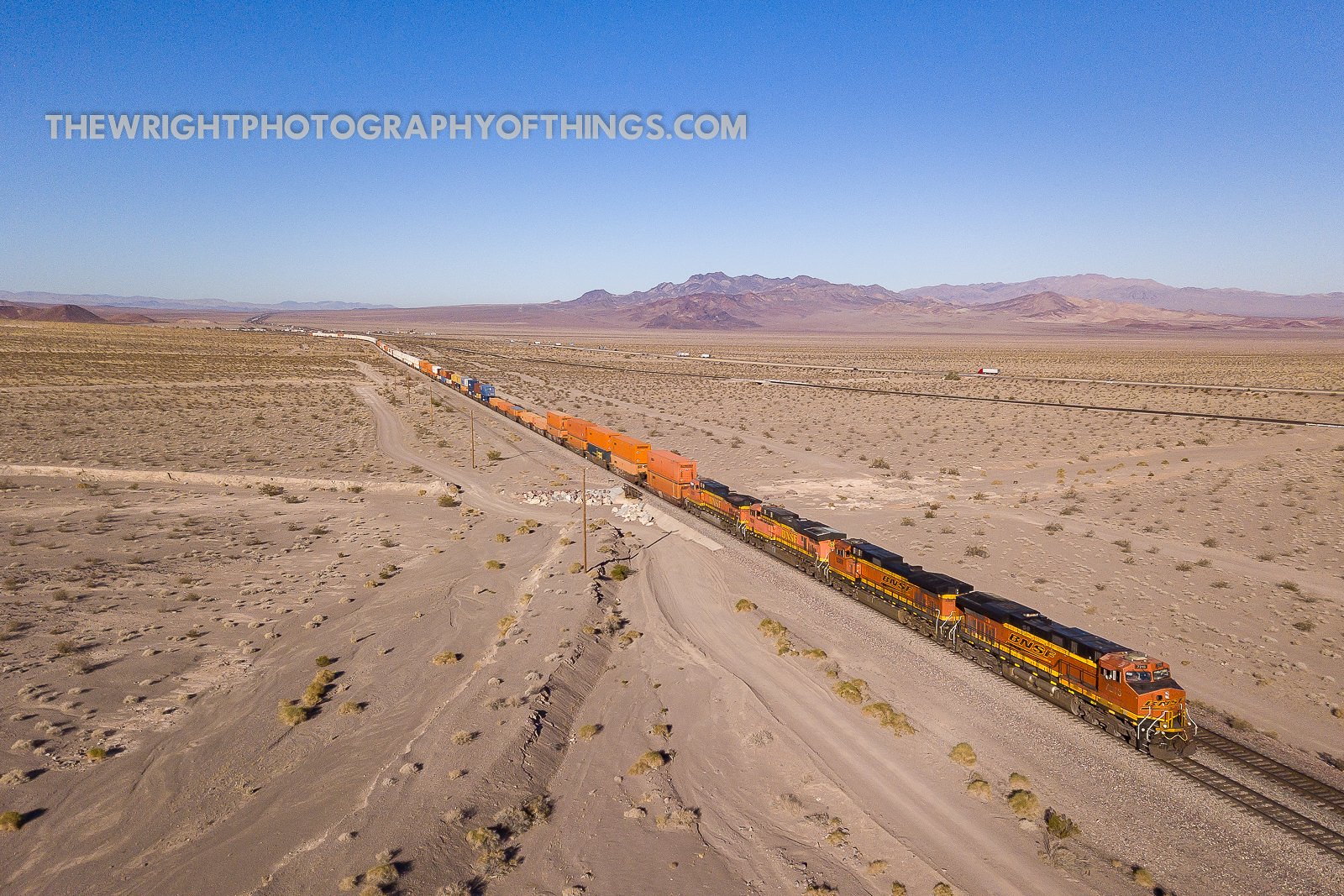 A quartet of BNSF power are running the former Santa Fe "Transcon" near Ludlow, California with an eastbound intermodal on November 1, 2019. Jon Wright photo.
A quartet of BNSF power are running the former Santa Fe "Transcon" near Ludlow, California with an eastbound intermodal on November 1, 2019. Jon Wright photo.COFC and TOFC service went through significant experimentation over the years by several different railroad.
The little Chicago Great Western Railway, a granger road operating trackage west of Chicago in the Heartland, is credited with pioneering TOFC’s widespread use.
The CGW proved that the commodity was a profitable venture and despite its regional status continued to grow the business before its takeover by the Chicago & North Western.
As the 1950s gave way to the 1960s TOFC service, also known as "piggyback" (because trailers "piggybacked" their journey by train), began to really gain momentum with many Class I railroads using it in one form or another. This led to the construction of new hubs and terminals specifically to handle TOFC service.
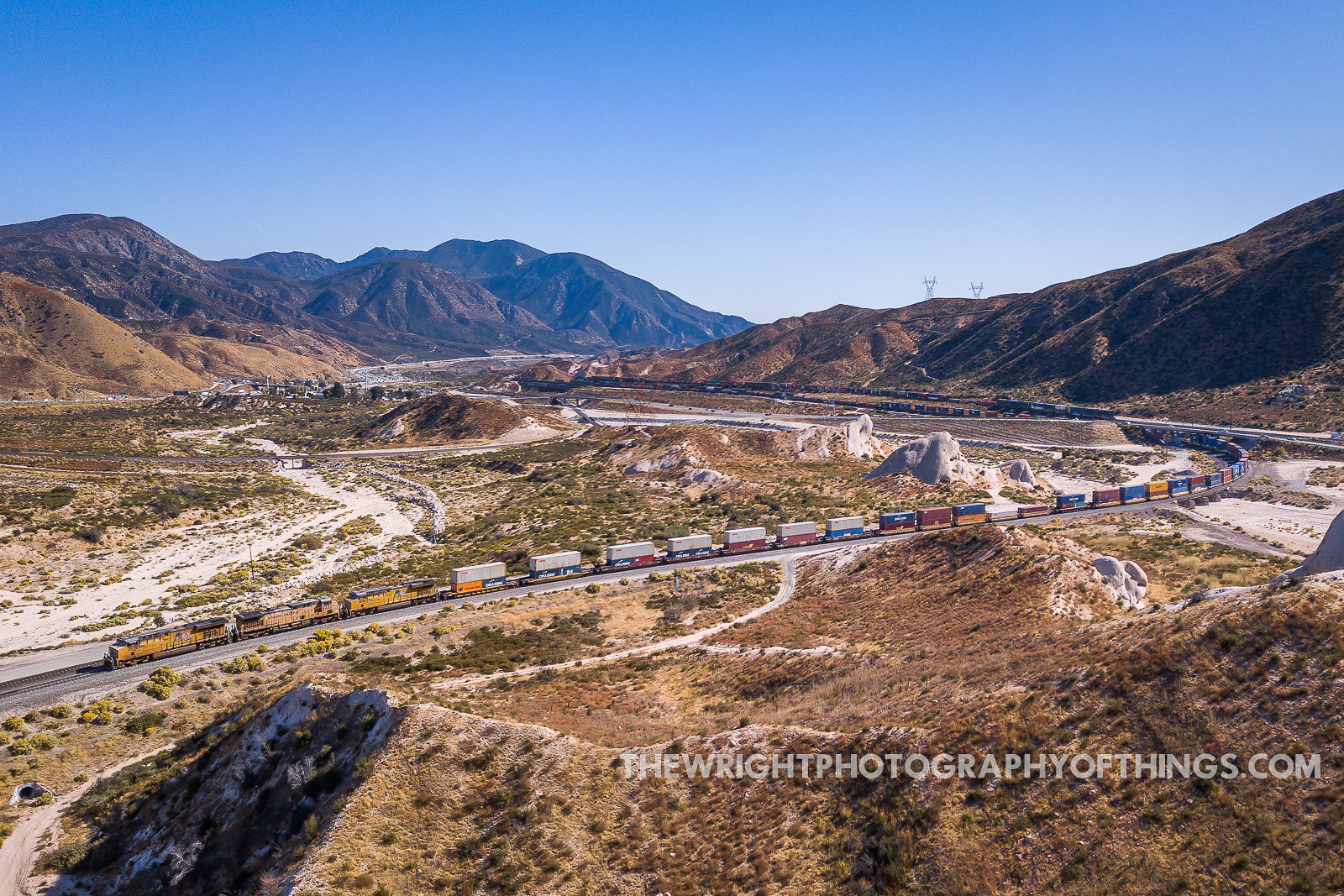 In this beautiful aerial view of Cajon Pass an eastbound Union Pacific container train is climbing upgrade on November 3, 2019. Jon Wright photo.
In this beautiful aerial view of Cajon Pass an eastbound Union Pacific container train is climbing upgrade on November 3, 2019. Jon Wright photo.As railroads do so well the advent of unit trailer trains soon took hold whereby the same commodity is blocked together.
Such movements at the time were usually given top priority over the particular route they operated (often known as "hotshots") with names like TrailerJet, Apollo, Razorback, Thunderhawk, and Flexi-Van. T
he change from "Trailer-On-Flatcar" to "Container-On-Flatcar" service began when the large ocean commerce industry started development of a new standard, international container that could more efficiently be loaded and unloaded at world ports.
What they came up with was today’s rectangle box configuration of 20 feet high by 40 feet long.
While railroads would continue to employ piggyback service (and still do, today, with specialized cars known as spine cars), there was a clear shift in COFC service when this new container became widely used.
For railroads, the widespread use of the container began in the 1980s. However, at first they found it rather difficult to transport because there was no specialized car to handle the equipment requiring the use of traditional flatcars.
The biggest problems railroads faced with this setup were the inefficiencies the car provided.
First, only one container could be transported on each car as two would make for a very dangerously high center of gravity while tunnel clearances could often not accommodate such heights.
Second, the containers were built to interlock with one another but with only one capable of being handled per car, each had to be manually secured with chains, which took an excruciatingly long time.
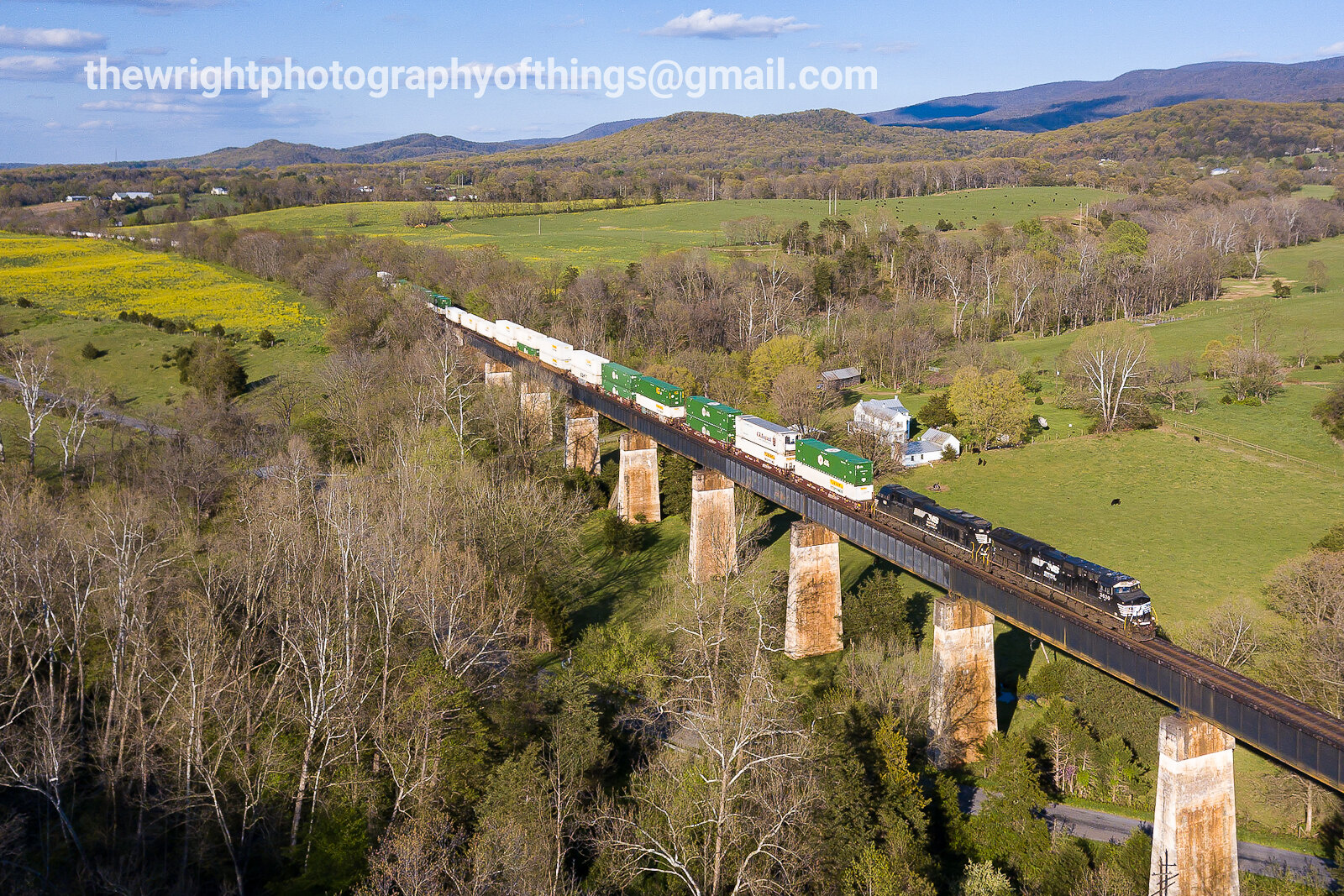 Norfolk Southern intermodal train 201 heads south across Jeremy Run Trestle just south of Rileyville, Virginia on April 18, 2020. Jon Wright photo.
Norfolk Southern intermodal train 201 heads south across Jeremy Run Trestle just south of Rileyville, Virginia on April 18, 2020. Jon Wright photo.This could not do and after working with freight car builders the railroads came up with the unique well cars of today, which are sort of a mix between a gondola and center-depressed flatcar (used to haul extremely heavy loads, they typically are equipped with six axles or more).
This design allows for two containers to be easily transported in each car with both sitting low enough that tunnel clearances became less pronounced.
Today, well cars are found in widespread use all across the country, better known as intermodal service, especially on the Norfolk Southern and BNSF Railways, which haul hundreds of thousands of containers per year.
Nearly all Class I's today derive a large portion of their traffic base from the movement of intermodal.
For instance, if you live near the BNSF Railway Transcon between Los Angeles and Chicago you can witness literally hundreds of nothing but container trains traveling between the two cities every day.
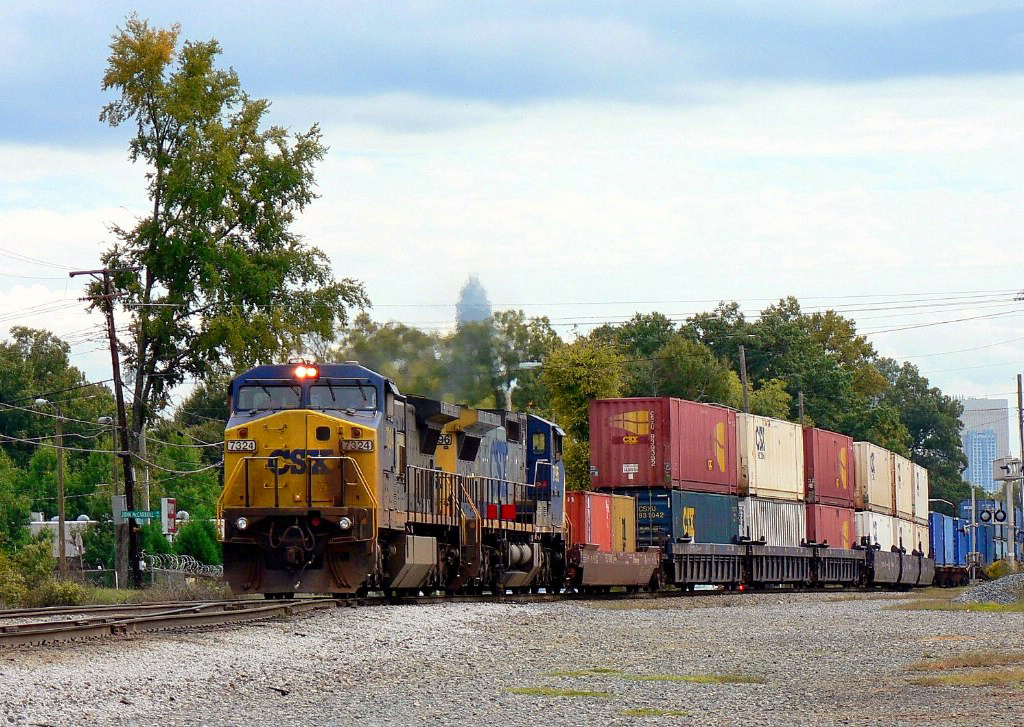 A pair of CSX C40-8Ws led by #7324 have intermodal freight Q182 at Pinoca Yard in Charlotte, North Carolina completing its run from Savannah, Georgia on October 10, 2009. Dan Robie.
A pair of CSX C40-8Ws led by #7324 have intermodal freight Q182 at Pinoca Yard in Charlotte, North Carolina completing its run from Savannah, Georgia on October 10, 2009. Dan Robie.The growth of this particular market has been such that eastern giants CSX and NS have spent billions of dollars updating major routes that continued to be plagued with tight clearances an issue western roads have largely avoided.
Known as the Heartland Corridor (NS) and National Gateway (CSX) projects they have allowed for the movement of double-stacks over their respective routes instead of single containers the carriers were forced to handle before.
Naturally, this has allowed for a great boon of freight and profit derived from a single train.
As the United States companies continue to outsource their products and imports remain high, expect the handling of intermodal freight to remain a major source of the rail industry's traffic base.
Recent Articles
-
New Jersey Dinner Train Rides In Woodstown
Jan 21, 26 11:20 AM
For visitors who love experiences (not just attractions), Woodstown Central’s dinner-and-dining style trains have become a signature offering—especially for couples’ nights out, small friend groups, a… -
Montana's Dinner Train Rides Near Lewistown!
Jan 21, 26 10:40 AM
The Charlie Russell Chew Choo turns an ordinary rail trip into an evening event: scenery, storytelling, live entertainment, and a hearty dinner served as the train rumbles across trestles and into a t… -
Kansas Valentine's Train Rides
Jan 21, 26 10:09 AM
While the railroad’s regular-season excursions are a big draw, the A&SV also shines with its calendar of themed trains—none more romantic than its Valentine’s Day special. -
Alabama Valentine's Train Rides
Jan 21, 26 09:39 AM
The Heart of Dixie Railroad Museum (HoDRM) is the kind of place where history isn’t parked behind ropes—it moves. This includes Valentine's Day weekend, where the museum hosts a wine pairing special. -
Wisconsin's Dinner Train Rides In North Freedom!
Jan 20, 26 01:55 PM
Featured here is a practical guide to Mid-Continent’s dining train concept—what the experience is like, the kinds of menus the museum has offered, and what to expect when you book. -
New York's Dinner Train Rides In The Adirondacks!
Jan 20, 26 12:41 PM
Operating over a restored segment of the former New York Central’s Adirondack Division, the Adirondack Railroad has steadily rebuilt both track and public interest in passenger rail across the region. -
Pennsylvania "Dinner Train" Rides In Boyertown!
Jan 20, 26 12:04 PM
With beautifully restored vintage equipment, carefully curated menus, and theatrical storytelling woven into each trip, the Colebrookdale Railroad offers far more than a simple meal on rails. -
New York ~ Murder Mystery ~ Dinner Train Rides
Jan 20, 26 12:03 PM
New York State, renowned for its vibrant cities and verdant countryside, offers a plethora of activities for locals and tourists alike, including murder mystery train rides! -
Pennsylvania ~ Murder Mystery ~ Dinner Train Rides
Jan 20, 26 11:48 AM
Pennsylvania, steeped in history and industrial heritage, offers a prime setting for a unique blend of dining and drama: the murder mystery dinner train ride. -
Florida Valentine's Train Rides
Jan 20, 26 11:46 AM
For couples looking for something different this Valentine’s Day, the museum’s signature romantic event is back: the Valentine Limited, returning February 14, 2026—a festive evening built around a tra… -
Connecticut Valentine's Train Rides
Jan 20, 26 11:43 AM
Operated by the Valley Railroad Company, the attraction has been welcoming visitors to the lower Connecticut River Valley for decades, preserving the feel of classic rail travel while packaging it int… -
Texas Dinner Train Rides At The TSR!
Jan 19, 26 12:30 PM
Today, TSR markets itself as a round-trip, four-hour, 25-mile journey between Palestine and Rusk—an easy day trip (or date-night centerpiece) with just the right amount of history baked in. -
Iowa's Dinner Train Rides In Boone!
Jan 19, 26 12:28 PM
If you’ve ever wished you could pair a leisurely rail journey with a proper sit-down meal—white tablecloths, big windows, and countryside rolling by—the Boone & Scenic Valley Railroad & Museum… -
Ohio Dinner Train Rides At The CVSR!
Jan 19, 26 12:27 PM
While the railroad is well known for daytime sightseeing and seasonal events, one of its most memorable offerings is its evening dining program—an experience that blends vintage passenger-car ambience… -
Missouri's Dinner Train Rides In Branson!
Jan 19, 26 12:21 PM
Nestled in the heart of the Ozarks, the Branson Scenic Railway offers one of the most distinctive rail experiences in the Midwest—pairing classic passenger railroading with sweeping mountain scenery a… -
Virginia Valentine's Train Rides
Jan 19, 26 12:15 PM
If you’ve ever wanted to slow life down to the rhythm of jointed rail—coffee in hand, wide windows framing pastureland, forests, and mountain ridges—the Virginia Scenic Railway (VSR) is built for exac… -
Maryland Valentine's Train Rides
Jan 19, 26 12:12 PM
The Western Maryland Scenic Railroad (WMSR) delivers one of the East’s most “complete” heritage-rail experiences: and also offer their popular dinner train during the Valentine's Day weekend. -
Indiana's Dinner Train Rides In Jasper!
Jan 18, 26 01:54 PM
In the rolling hills of southern Indiana, the Spirit of Jasper offers one of those rare attractions that feels equal parts throwback and treat-yourself night out: a classic excursion train paired with… -
New Mexico's Dinner Train Rides
Jan 18, 26 01:37 PM
If your heart is set on clinking glasses while the desert glows at sunset, you can absolutely do that here—just know which operator offers what, and plan accordingly. -
New Hampshire ~ Murder Mystery ~ Dinner Train Rides
Jan 18, 26 01:10 PM
The state's murder mystery trains stand out as a captivating blend of theatrical drama, exquisite dining, and scenic rail travel. -
New York Valentine's Train Rides
Jan 18, 26 12:32 PM
At its best, the Adirondack Railroad delivers exactly what railfans and casual riders alike hope for: vintage coaches, classic depots, rivers and forests right outside the window. -
Washington Valentine's Train Rides
Jan 18, 26 10:50 AM
Whether you’re a dedicated railfan chasing preserved equipment or a couple looking for a memorable night out, CCR&M offers a “small railroad, big experience” vibe—one that shines brightest on its spec… -
Colorado Valentine's Train Rides
Jan 18, 26 10:49 AM
The Royal Gorge Route Railroad is the kind of trip that feels tailor-made for railfans and casual travelers alike, including during Valentine's weekend. -
Georgia Valentine's Train Rides
Jan 18, 26 10:42 AM
f you’ve ridden the SAM Shortline, it’s easy to think of it purely as a modern-day pleasure train—vintage cars, wide South Georgia skies, and a relaxed pace that feels worlds away from interstates and… -
New Jersey ~ Murder Mystery ~ Dinner Train Rides
Jan 17, 26 01:16 PM
There are currently no murder mystery dinner trains available in New Jersey although until 2023 the Cape May Seashore Lines offered this event. Perhaps they will again soon! -
West Virginia Dinner Train Rides In Elkins!
Jan 17, 26 01:08 PM
The D&GV offers the kind of rail experience that feels purpose-built for railfans and casual travelers. -
Virginia Dinner Train Rides In Staunton!
Jan 17, 26 11:55 AM
If you’ve ever wished you could pair a classic scenic train ride with a genuinely satisfying meal—served at your table while the countryside rolls by—the Virginia Scenic Railway was built for you. -
Florida Easter Train Rides
Jan 17, 26 10:23 AM
The cold weather rarely invades Florida and the state nearly always warm and balmy early spring temperatures. Learn more about where you can find Easter-themed train rides across the Sunshine State. -
Ohio Easter Train Rides
Jan 17, 26 10:13 AM
Ohio is home to several museums and excursion trains preserving the state's rich railroading heritage. A few of these locations host Easter-themed train rides each spring. -
Massachusetts Valentine's Train Rides
Jan 17, 26 09:58 AM
The Cape Cod Central Railroad (CCCR) blends classic New England scenery with heritage equipment, narrated sightseeing, and some of the region’s best-known “rails-and-meals” experiences. -
California Valentine's Train Rides
Jan 17, 26 09:53 AM
Operating out of West Sacramento, this excursion railroad has built a calendar that blends scenery with experiences—wine pours, themed parties, dinner-and-entertainment outings, and seasonal specials… -
South Carolina Dinner Train Rides
Jan 16, 26 11:13 PM
There is only location in the Palmetto State offering a true dinner train experience can be found at the South Carolina Railroad Museum. Learn more here. -
Rhode Island Dinner Train Rides
Jan 16, 26 11:01 PM
Despite its small size, Rhode Island is home to one popular dinner train experience where guests can enjoy the breathtaking views of Aquidneck Island. -
Pennsylvania's Thomas The Train Rides
Jan 16, 26 04:13 PM
"A Day Out With Thomas” train rides offer a unique opportunity for children and their families to engage in a magical and memorable experience, setting the stage for a full day of fun and adventure. -
Illinois's Thomas The Train Rides
Jan 16, 26 02:23 PM
In Illinois, the "A Day Out With Thomas" event offers a unique chance for families to immerse themselves in the enchanting world of Thomas and friends, creating memories that last a lifetime. -
New Jersey's Thomas The Train Rides
Jan 16, 26 02:11 PM
Here's a comprehensive guide to what you can expect at Day Out With Thomas events in New Jersey. -
Texas ~ Murder Mystery ~ Dinner Train Rides
Jan 16, 26 01:54 PM
Here’s a comprehensive look into the world of murder mystery dinner trains in Texas. -
Connecticut ~ Murder Mystery ~ Dinner Train Rides
Jan 16, 26 01:26 PM
All aboard the intrigue express! One location in Connecticut typically offers a unique and thrilling experience for both locals and visitors alike, murder mystery trains. -
New Hampshire Dinner Train Rides In N. Conway!
Jan 16, 26 10:47 AM
Tucked into the heart of New Hampshire’s Mount Washington Valley, the Conway Scenic Railroad is one of New England’s most beloved heritage railways -
Oregon Dinner Train Rides Near Mt. Hood!
Jan 16, 26 10:44 AM
The Mt. Hood Railroad is the moving part of that postcard—a century-old short line that began as a working railroad. -
Maryland's - Wine Tasting - Train Rides
Jan 15, 26 02:59 PM
This article delves into the enchanting world of wine tasting train experiences in Maryland, providing a detailed exploration of their offerings, history, and allure. -
Colorado's - Wine Tasting - Train Rides
Jan 15, 26 02:46 PM
To truly savor these local flavors while soaking in the scenic beauty of Colorado, the concept of wine tasting trains has emerged, offering both locals and tourists a luxurious and immersive indulgenc… -
Iowa ~ Wine Tasting ~ Train Rides
Jan 15, 26 02:36 PM
The state not only boasts a burgeoning wine industry but also offers unique experiences such as wine by rail aboard the Boone & Scenic Valley Railroad. -
Georgia's Wine Train Rides In Cordele!
Jan 15, 26 02:26 PM
While the railroad offers a range of themed trips throughout the year, one of its most crowd-pleasing special events is the Wine & Cheese Train—a short, scenic round trip designed to feel like a t… -
Indiana ~ Murder Mystery ~ Dinner Train Rides
Jan 15, 26 02:22 PM
This piece explores the allure of murder mystery trains and why they are becoming a must-try experience for enthusiasts and casual travelers alike. -
Ohio ~ Murder Mystery ~ Dinner Train Rides
Jan 15, 26 02:10 PM
The murder mystery dinner train rides in Ohio provide an immersive experience that combines fine dining, an engaging narrative, and the beauty of Ohio's landscapes. -
Nevada Dinner Train Rides In Ely!
Jan 15, 26 02:01 PM
If you’ve ever wished you could step through a time portal into the hard-working world of a 1900s short line the Nevada Northern Railway in Ely is about as close as it gets. -
Michigan Dinner Train Rides In Owosso!
Jan 15, 26 09:46 AM
The Steam Railroading Institute is best known as the home of Pere Marquette #1225 and even occasionally hosts a dinner train! -
Arizona's - Wine Tasting - Train Rides
Jan 14, 26 02:04 PM
For those who want to experience the charm of Arizona's wine scene while embracing the romance of rail travel, wine tasting train rides offer a memorable journey through the state's picturesque landsc… -
Arkansas's - Wine Tasting - Train Rides
Jan 14, 26 01:57 PM
This article takes you through the experience of wine tasting train rides in Arkansas, highlighting their offerings, routes, and the delightful blend of history, scenery, and flavor that makes them so…

